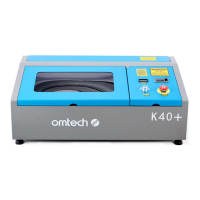25
During repetitive engraving and cutting, periodically check your temperature gauge to maintain a water
temperature below 100°F (38°C). If this temperature is reached, stop work and allow your device to cool
before further use.
Step 11. When you have fi nished engraving, close your engraving software and then turn off your machine in the
following order: the laser power supply (by removing your laser key from the control panel), the control
system (by pushing down the emergency power button), any ventilation device, and—after providing some
time for your tube to cool—the water cooling system.
Step 12. Fully clean the workbed and main bay. For best results, disconnect your laser engraver from its power
supply between uses. Unplug it or turn off its intermediary surge protector.
4.3 Instructions for Specifi c Materials
The following instructions are suggestions to help speed safe work with a range of materials. The user should research
the specifi c safety and engraving requirements of their specifi c material to avoid the risk of fi re, hazardous dust,
corrosive and poisonous fumes, and other potential problems. Once the product is known to be safe or appropriate
protective equipment has been set up, it can be helpful to engrave a test matrix of small boxes produced at various
speed and power settings to discover the ideal settings for your design. Alternatively, start with low power and fast
speed settings and rerun your design as many times as needed, using progressively greater laser intensity.
Ceramics
When engraving on ceramics, generally use moderate to high power. Using more loops rather than higher power and
lower speed can help avoid cracking the material during work. Be mindful of the health risk posed by dust generated
from ceramic engraving, especially for repetitive industrial applications. Depending on the material and the amount
of work, a fan or even full ventilation system may be required to address the problem. Similarly, operators and others
in the work area may need to use breathing PPE such as masks and respirators.
Glass
When engraving glass, generally use high power and low speed. As with ceramics, it can be helpful to run more
loops at lower settings to avoid cracks. Care must be taken when engraving fi berglass and carbon fi ber to avoid
combinations of settings that produce a laser intensity great enough to damage the structural integrity of its component
fi bers, producing blurry marking. PPE should be worn to avoid exposure of the eyes, nose, mouth, and skin to the
dust produced by working with either material, especially for repetitive industrial applications. Clothing worn while
working with fi berglass should be washed separately afterward.
Leather
When engraving leather products, generally use low to moderate power at high speed. Natural leather should be
engraved slightly slower and at slightly higher power than artifi cial leather. Be especially attentive to the possibility
of fi re, as well as the dust produced in repetitive applications.
Metal
CO₂ laser engravers should not be used for marking, engraving, or cutting metal. They are best suited for working
coatings applied to a metal base, and care must be taken not to attempt work on the underlying metal itself. A variety
of coatings specialized for CO₂ engraving are available, and the user should follow the instructions provided as the
parameters vary from product to product and metal to metal. Generally, work on aluminum coatings should be done
more quickly at lower power, and work on steel coatings can be done more slowly at higher power.

